Archived Water Damage Blog Posts
How to Prevent Bacterial Growth After a Water Leak
12/13/2023 (Permalink)
While Bel Air, CA, is known for its luxury and elegance, no home is immune to water leaks. Beyond the visible damage, water can create an environment conducive to bacterial growth, posing several potential risks. In this blog, we'll explore essential tips to prevent bacterial growth after water intrusion in your Bel Air home.
Understanding the Bacterial Threat
When water enters your home, it can introduce various bacteria and pathogens. Bacterial growth is not only unsightly but can also lead to several issues. Common bacteria found in water-damaged areas include E. coli, Salmonella, and mold-related bacteria. Preventing them is crucial.
Key Steps to Prevent Bacterial Growth
Safety First
Before addressing bacterial growth, ensure your safety. Turn off electrical power if necessary and wear appropriate protective gear, especially when dealing with contaminated water.
Prompt Cleanup
Time is of the essence. Begin the cleanup process as soon as possible to minimize the chances of bacterial growth. Remove standing water and moisture promptly.
Remove Wet Materials
Bacteria can thrive in porous materials like carpeting, drywall, and insulation. If these materials are saturated, they should be removed to prevent bacterial colonization.
Thorough Drying
Proper drying is critical. Use fans, dehumidifiers, and open windows to ensure thorough ventilation and drying of affected areas. Moisture promotes bacterial growth.
Disinfection
Use appropriate disinfectants on cleaned surfaces to kill bacteria. Follow manufacturer instructions and ensure surfaces are thoroughly disinfected.
Monitor Humidity Levels
Maintaining low humidity levels in your home is essential. Bacteria thrive in high-humidity environments. Invest in a hygrometer to monitor humidity levels and use dehumidifiers if needed.
Inspect for Mold
Mold is a common byproduct of water intrusion and can host harmful bacteria. Regularly inspect for mold growth and address it promptly.
Ventilation
Proper ventilation is crucial to preventing bacterial growth. Ensure good airflow within your home, especially in areas prone to moisture, like bathrooms and kitchens.
Professional Assistance
While these steps are essential for preventing bacterial growth after water intrusion, it's often wise to seek professional assistance. SERVPRO® of Bel Air/West Hollywood specializes in water damage restoration, including the prevention of bacterial growth. Our trained technicians have the expertise and equipment to handle water damage effectively, ensuring your home is not only dry but also free from harmful bacteria and pathogens.
In Bel Air, CA, safeguarding your home's cleanliness and comfort means addressing water intrusion promptly and effectively. Preventing bacterial growth is an essential part of the process. Whether you choose to tackle the cleanup yourself or seek professional assistance, prioritizing safety and thorough drying is key. SERVPRO® of Bel Air/West Hollywood is here to support our community, providing expertise and services tailored to your unique needs. Remember, when it comes to water damage and bacterial prevention, acting swiftly is your best defense.
Will the Insurance company cover my Broken Pipe?
3/8/2023 (Permalink)
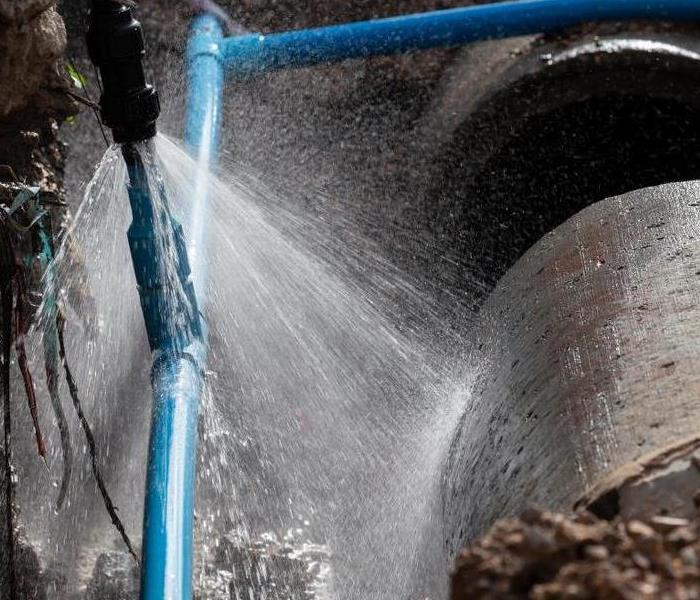 If you have a broken pipe, call a professional immediately.
If you have a broken pipe, call a professional immediately.
If your home has a broken pipe, you need to act quickly. It may be time to call your insurance company and ask if they'll cover the damage. However, if you don't have a homeowner's policy in place yet or feel like it doesn't cover enough of the costs associated with repairing a broken pipe.
What insurance covers?
Homeowner insurance can cover a wide range of emergencies in your home. You may not be able to get insurance for a broken pipe specifically, and even if you do, the policy might not cover the full cost of the repair.
If you don't have insurance and need to pay for repairs yourself, there are some things to keep in mind. Check with your local utility companies and plumbers' associations before hiring anyone to do work on your plumbing system. They may be able to recommend reputable contractors who offer reasonable rates.
Call a Professional.
If you have a broken pipe, it is important to call a professional immediately. They will send someone out to assess the damage and determine what steps need to be taken next. The insurance company will likely send someone out right away to fix the pipe and clean up any water damage that may have occurred in your home or business.
You will probably need to hire a plumber to fix the broken pipe and clean up the water damage.
If your home insurance policy covers broken pipes, you may be able to get help with paying for repairs and cleanup costs from your insurance company. In order for this to happen, however, it's important that you tell them about the problem as soon as possible after discovering it--and before any major damage has occurred in your home or yard (like mold).
Broken water main.
Your home insurance may cover some of the cost of fixing your broken water main.
If you have a plumbing emergency, such as a burst pipe or sewage backup, and it causes damage to your property, your home insurance may pay for part of the repairs needed to fix that damage. However, most policies do not cover water main breaks (or "breaks" in general) because they're considered "abnormal occurrences." To find out if yours does, check with an agent or review your policy documents carefully before calling them up to make sure they'll be able to help you out with any claims related to broken pipes in your home.
Flood waters in your home.
Your policy may also cover some of the damage done by the flood waters in your home. You may need to pay a deductible, but this will be less than if you had to pay for everything out of pocket. You should check with your insurance company about what types of damages are covered under your policy and how much they'll reimburse you for them.
If you have a broken pipe, it's important to know if your home insurance will cover the damage it causes. You should call your insurance company immediately and ask about coverage options for this type of incident. If your policy does not cover broken pipes or floods, then you may need to find another way to pay for repairs or clean-up costs.
What Is Category 1 Water Damage?
12/2/2022 (Permalink)
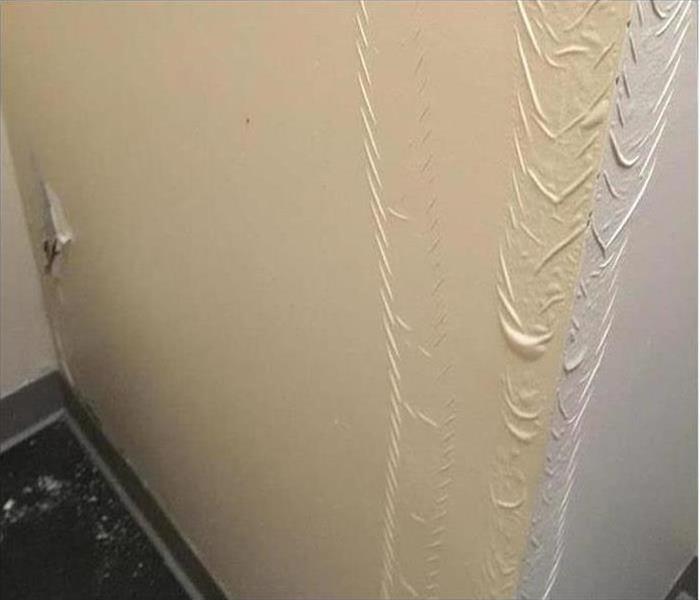 This wall's water leak demonstrates the rippling effects of water damage.
This wall's water leak demonstrates the rippling effects of water damage.
What is Category 1 Water Damage and How Do You Fix It?
Category 1 water damage is clean water. Category 1 water is typically caused by a small leak in faucets or pipes in your home or business. It may also be the result of a sink overflow or other appliance malfunction. The best thing to do when you encounter category 1 water damage is to take immediate action and contact your insurance company immediately so they can assess the situation and help you decide how best to proceed with repairs.
Category 1 water damage is clean water.
Category 1 water damage is clean water. It is not sewage, or chemical. It is not contaminated with other materials and does not require special disposal methods.
The presence of any of these contaminants in your Bel Air, CA home could make it a category 2 or 3 water event and therefore more expensive to repair the damage done to your property. Category 2 and 3 water damage requires professional remediation by a licensed restoration company that offers full insurance coverage.
What are the sources of category 1 water damage?
Category 1 water damage can be caused by several things, including:
- broken water supply lines or excessive pressure in the system.
- overflowing dishwasher or washing machine.
- leaking roof or sprinkler system.
- burst pipes.
How do you handle category 1 water damage?
If you've ever had a pipe burst or a toilet overflow, then you know how frustrating it can be to deal with water damage. Not only does it leave unsightly stains on your carpet, walls, and wood flooring, but it can also cause mold to grow if not dried properly.
To avoid these issues altogether—and keep your home safe—it's important that you call a highly experienced and trained water mitigation expert, such as SERVPRO of Bel Air.
3 things to do after a Category 1 water loss.
- Remove all traces of water from floors, carpets, countertops etcetera if possible—but only if it won't ruin anything else around them!
- Dry out the area as quickly as possible. When dealing with Category 1 water damage, you want to dry out everything as quickly as possible—otherwise mold will grow and cause more problems. The longer moisture stays in an area, the greater risk there is for mold growth and other complications down the line, such as serious structural damage.
- Call a professional. If you have water damage that’s not obvious and you can’t tell where it started, don’t try to tackle the problem yourself. If a Category 1 situation has occurred, call in the pros right away: they will be able to assess what needs to be done and get started on drying out your belongings before mold starts growing.
Category 1 water damage must be taken care of immediately
Though Category 1 water damage is not as serious as category 2, it still needs to be taken care of. It can cause mold, mildew, and other issues like structural damage to the property. It is important to clean up the water immediately so that you are not putting yourself or your family at risk for any health problems in the future.
In conclusion, category 1 water damage can be a lot more serious than it may seem. It is important to get any water damage repaired immediately so that you don’t end up facing bigger problems down the road. If your property has suffered from category 1 water damage, contact us today for professional water restoration services!
What Should You Do If Your Toilet Overflows?
11/7/2022 (Permalink)
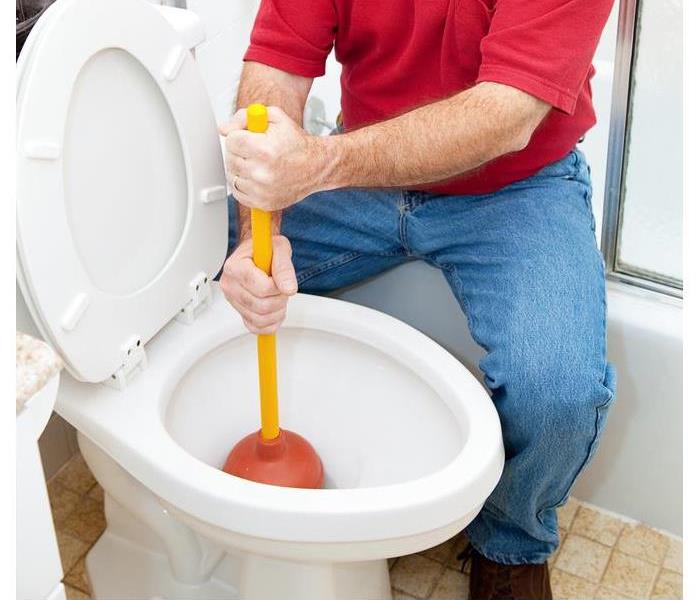 Plunge the toilet
Plunge the toilet
What Happens If Your Toilet Overflows?
If your toilet overflows, you need to act fast. When a toilet overflows, the first thing people tend to do is flush it again. That's the worst thing you can do. Flushing will only make the problem worse by sending more water into the bowl and potentially damaging your flooring. Read the article down below to learn what you should do if your toilet overflows.
Turn Off the Water Supply to the Toilet
If your toilet begins to overflow, turn off the water supply line to the toilet. Most toilets are connected by a control valve that is attached to the side of the bowl and can be turned using a wrench. This will stop water from entering your toilet through that line. This will prevent any damaged walls or floors resulting from the excess water overflowing.
Turning off this valve should stop any further overflow problems until you have time to take care of them.
Don't flush
If your toilet overflows, don't flush it. You've probably already figured that much out. The next step is to keep anything else from going into the toilet as well—don't put anything in there! If you think of something that needs to go down the drain while your sink isn't working, just use a bucket or something else instead.
And finally, don't use the bathroom at all! If you really need to go, try using an alternative means. That way you don't accidentally make things worse by adding more wastewater into an already overflowing system.
Remove the Excess Water from the Bowl
The next step is to remove as much excess water from the bowl as you can. While it’s tempting to reach down into the bowl, this isn’t a good idea because you may get hurt. Instead, use a wet vacuum or bucket to scoop up as much water as possible. Be sure not to use your hands—you might end up with cuts from broken pieces of porcelain or other objects that were in your toilet before it overflowed.
Plunge the Toilet
Plunging is an easy technique that can be used to remove the blockage from the toilet. To do so, put a rubber plunger on the drain opening and push down gently but firmly until all of the remaining water is drained away.
Call a plumber
If you don't know how to fix your toilet, call a plumber. This is one of those things that you might think you could do yourself, but as we've established in this article, there's more to it than just turning off the water. A good plumber should be able to solve your problem in no time at all—and charge less than if you tried to do it yourself.
When choosing a plumber to help with an overflowing toilet and other plumbing issues, consider these tips:
- Talk with friends and family who have hired a plumber before; ask them which ones they recommend.
- Check out online reviews from websites like Yelp and Angie's List or search for local companies on Google Maps.
- Research any company's reputation by doing some research online.
By following these steps, we hope that you can avoid the unpleasant experience of water damage to your bathroom. If you have any questions or need more advice on what to do next, please don’t hesitate to contact us today!
How To Help Your Carpet Recover From Water Damage
7/15/2022 (Permalink)
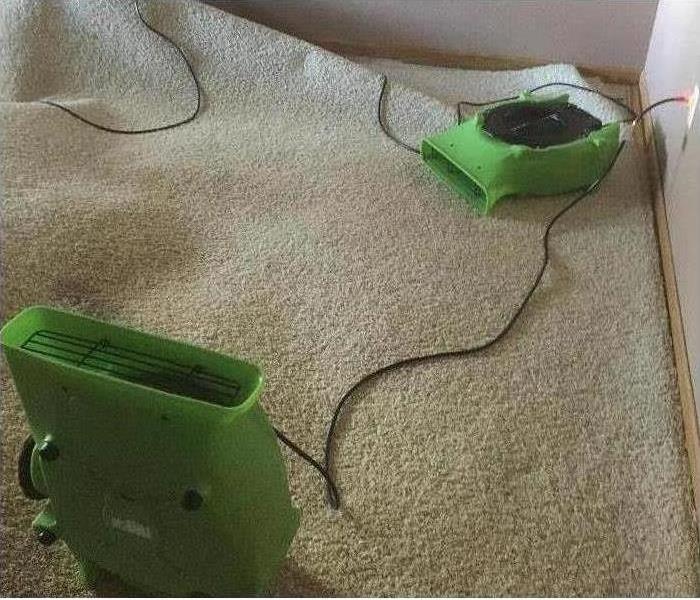 Drying carpet in a home in Melrose District, CA.
Drying carpet in a home in Melrose District, CA.
How To Clean Your Carpet and Help it Recover From Water Damage
If a pipe breaks or bursts in your Melrose District, CA, home, it can quickly lead to various forms of water damage. Porous materials such as carpets tend to be more severely affected by water, which means it’s crucial to restore your wet carpeting as soon as possible. Failing to take immediate action may lead to mold growth or other types of harm. Keep these guidelines in mind to properly clean your carpet and help it recover from water damage after a pipe break.
Dry the Area
To prevent any further damage from occurring, be sure to thoroughly dry all wet areas of your home immediately. Be sure to point fans towards your carpets as well as the surrounding space to ensure that all moisture evaporates completely. Drying your home during the restoration process can help accomplish the following:
- Circulating fresh air
- Removing excess moisture
- Preventing mold growth
In addition, removing any leftover water from your carpeting can keep water damage under control until help arrives.
Inspect Your Home
Water damage has a way of hiding in the most unexpected areas of your home. To properly assess the level of damage after a pipe break, be sure to inspect your living space from top to bottom. This includes checking your carpet padding as well as the carpets themselves to identify any traces of moisture.
Call a Professional
After a pipe breaks in your home, it’s crucial to take the proper measures to keep any additional harm at bay. Once you’ve done your part, though, be sure to call an experienced professional who can handle the problem. An expert can identify any signs of water damage that you didn’t notice on your own and help restore your home immediately.
A pipe break is a major source of stress for many homeowners. However, with the help of water damage restoration professionals, your home can return to its normal state in no time.
4 Types of Secondary Damage After a Water Spill
5/18/2022 (Permalink)
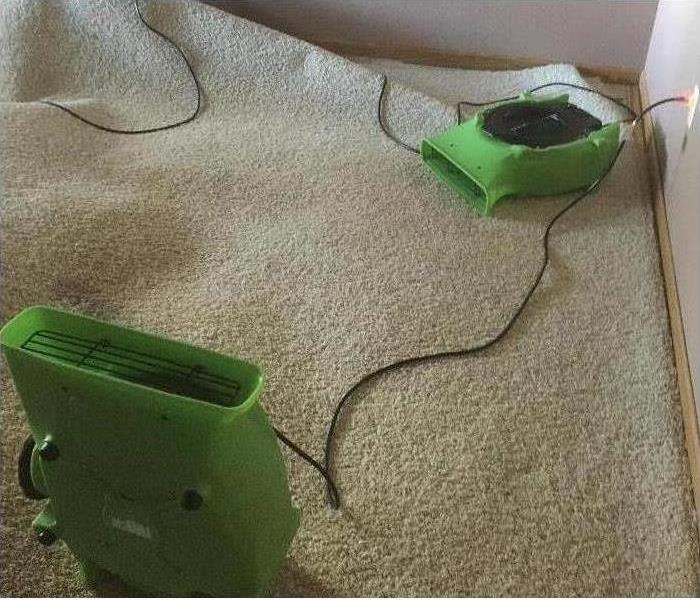 Drying carpet in a home in Weho, CA.
Drying carpet in a home in Weho, CA.
After a Water Spill, There Are Four Types of Secondary Damage
A water spill in your home is an unpleasant experience and one that could be quite disruptive. The primary event is bad enough, with a combination of standing water, saturated items and even ruined flooring and furniture. However, if the cleanup job is not done correctly or takes too long to begin, your home in Weho, CA, could also be at risk for black mold.
1. High Humidity
Your home is most comfortable under certain conditions. A water leak puts your home at risk of too much moisture in the air. You should aim for a level of between 30-60% humidity. Anything higher could cause mold growth. This is why professional drying by a professional water damage mitigation team is so important. It will significantly reduce the chance of black mold gaining a foothold in your home.
2. Lingering Smells
Ineffective cleaning and sanitizing can result in unpleasant odors. This could be a musty scent, or it could be something stronger. This type of secondary damage might not appear for a few days after a cleaning, but it will show up if proper cleaning methods were not utilized.
3. Additional Damage to Carpeting
After a home water spill, carpeting can absorb a lot of moisture. If the water is dirty, the carpeting must be thoroughly cleaned, including the underlying padding layer, and in some cases, it will need to be thrown out. If the carpeting isn't cleaned and dried, it could quickly deteriorate.
4. Additional Damage to Insulation
Wall insulation can also become collateral damage after a water spill. Since this occurs behind the walls, it can be easy to miss. Wet insulation will have a hard time drying out completely and it will lose some of its insulating value.
Black mold is one of the most serious results of poor water cleanup. Other forms of damage can also occur that require a follow-up from a professional company.
How To Reduce The Risk and Cost of Water Damage To Your Building
3/6/2022 (Permalink)
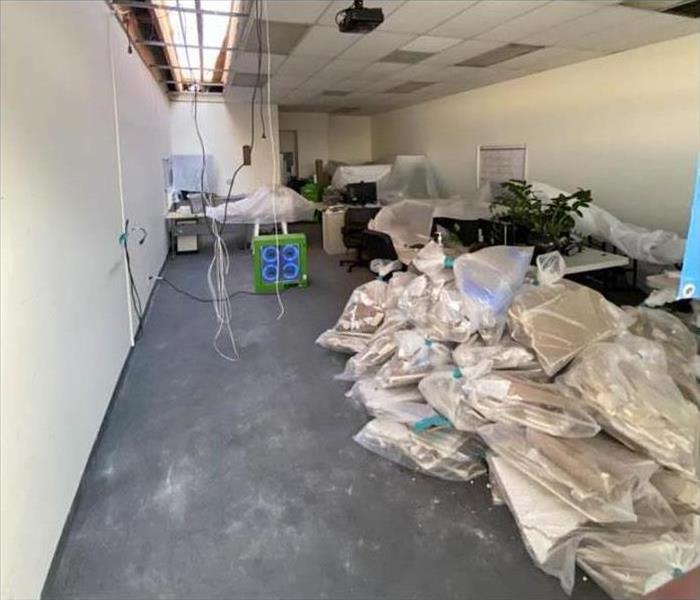 Commercial water restoration in Spaulding Square, CA.
Commercial water restoration in Spaulding Square, CA.
An undetected water leak can lead to significant water damage to your business in Spaulding Square, CA. Although a sudden pipe break can cause gallons of water to flood your space, slowly evolving leaks from various sources can also have significant ramifications and are often preventable.
What Are Common Causes of Building Leaks?
Water can enter your building in various ways, but routine building maintenance can reveal necessary repairs to prevent this from happening. Among the common causes for leaks in a commercial building are:
- Foundation cracks
- Doors and windows with broken seals
- Clogged drains
- Roof damage
- Faulty HVAC system
Undertaking routine inspections of your building's premises is the best way to prevent potential leaks.
How Can Leaks Damage Your Building or Cost You Money?
Gradual leaks can cause significant financial losses when building owners neglect to practice routine maintenance for detecting potential problems. Roof, plumbing and other building inspections are among the necessary measures building owners can take to avoid a water leak, potentially leading to mold formation.
Signs of mold include damp spots and brown stains on walls, ceilings or floors. A musty odor indicates that mold spores have penetrated the air, and it may be necessary to hire a mold remediation service to perform air filtration and odor removal.
Although insurance policies may cover widespread water damage resulting from a sudden or unavoidable water pipe break, delaying drying efforts can reduce a claim's value. It is vital to contact a flood restoration company to remove excess moisture from the environment with commercial-grade wet vacuums. In other instances, timely repairs can address small leaks before they grow or allow water to accumulate over time, causing unnecessary property damage that may not qualify for an insurance claim.
A water leak of any size can easily lead to costly damage to your building in Spaulding Square, CA. Routine maintenance and structural repairs can help ensure your facility remains in the best shape possible to avoid many problems.
What to Know When Damage Occurs to Bathroom Supply Lines
2/10/2022 (Permalink)
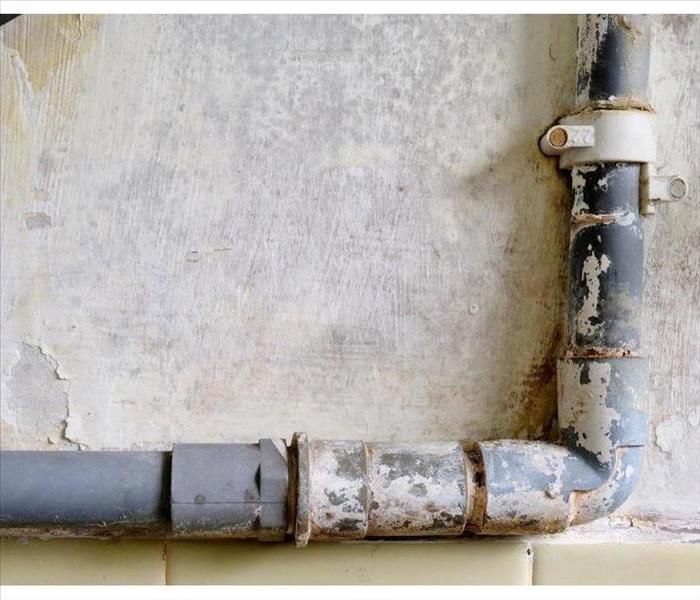 When supply line damage happens to you in Bel Air, CA, there’s no reason to panic.
When supply line damage happens to you in Bel Air, CA, there’s no reason to panic.
What to Do If Your Bathroom Supply Lines Are Damaged
Experiencing a bathroom leak in Bel Air, CA? Supply line damage could be the culprit. But how can you be sure if damage isn’t immediately visible? When a ruptured line is causing the problem, what should you do next? If you suspect that a supply line leak is occurring in your home, it’s important to contact licensed professionals who can help repair the issue and provide restoration for water damages. Here are a couple of things you’ll want to keep in mind as you navigate the process.
Warranties Will Vary Depending on the Material Used
Water supply lines can be fashioned from a variety of components including:
- Plastic
- Copper
- PEX
- Braided stainless steel
Many come with a warranty at time of installation, but because certain types are more prone to supply line damage than others, the length of your coverage will vary. For example, plastic piping is generally guaranteed for 5-8 years while braided stainless steel lines frequently include lifetime warranties.
Take Short-Term Measures to Help Avoid Further Leakage
As soon as a bathroom leak is recognized, it’s important to shut down the flow of water through the damaged line by turning the control valve off. If the damage is especially severe, you may need to apply a pipe repair clamp as a temporary measure. Water can cause structural damage that cannot necessarily be seen with the naked eye. Therefore, it’s crucial to contact a respected cleanup and restoration specialist as soon as possible regardless of how severe the situation may seem.
Having a bathroom that’s out of order due to a leak can cause some serious disruption in your home life. When supply line damage happens to you in Bel Air, CA, there’s no reason to panic. Armed with a little knowledge and the help of a cleanup and restoration company you can trust, your residence will be back to the status quo in no time.





 24/7 Emergency Service
24/7 Emergency Service






